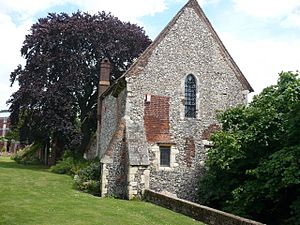Greyfriars, Canterbury facts for kids
Greyfriars in Canterbury was the very first Franciscan friary (a type of religious community) built in England. It has a long and interesting history, from its early days as a home for friars to becoming a private house and then a peaceful garden and chapel.
Contents
The Story of Greyfriars
The first Franciscans, also known as 'Greyfriars', came to England in 1224. They were followers of St Francis of Assisi and were called 'Greyfriars' because they wore simple grey clothes with a rope belt. This belt had three knots, which stood for their promises of poverty (owning very little), chastity (not marrying), and obedience (following their leaders).
Building the Friary
At first, the Franciscans wanted to live in very simple buildings to show their poverty. But by 1250, they realized they needed proper land and buildings to live and work. So, in 1267, the Canterbury friary began to be rebuilt using stone. A kind man named Alderman John Digge, who used to be a leader in Canterbury, donated the land. The main church within the friary was officially opened in 1325 by Archbishop Walter Reynolds.
Changes and Challenges
Later, in 1498, the Canterbury friary became part of a stricter group of Franciscans called the Observant Franciscans. King Henry VII of England supported this group.
However, things changed when his son, Henry VIII, became king. Henry VIII wanted to be the head of the new Church of England, but the Greyfriars brothers did not agree. In 1534, some brothers were put in prison, and two of them, along with their leader Richard Risby, were even executed. This happened because they refused to accept the King's new rules and supported a woman named Elizabeth Barton. She was a nun who had spoken out against Henry VIII's divorce from Catherine of Aragon and his marriage to Anne Boleyn.
In December 1538, all the friaries in Canterbury, including Greyfriars, were taken over by the King's representatives. The remaining friars were given a small amount of money and sent away.
What We See Today
Today, you can still see parts of the old friary. The 13th-century building that crosses the river is still standing and is now known as the Greyfriars Chapel. You can also see parts of the old friary church and a stone bridge. Digging has also shown where other parts of the friary, like the main church area and a bell-tower, used to be. Friaries usually had dining halls, sleeping areas, and libraries, but the exact layout of Greyfriars is still a bit of a mystery!
Greyfriars House and Its Uses
After the friary was closed down, the property was sold to different owners. It became a private house for many centuries.
A Temporary Prison
It's believed that one room in the old guesthouse (now Greyfriars Chapel) was used as a temporary prison cell in the late 1700s. Prisoners who were waiting to be sent away would stay there. You can still see names and dates carved into the wooden walls by these prisoners, like "T Woollett, November 1819, for 14 days for running." This gives us a glimpse into the past lives of people who were there.
Gardens and Businesses
In the 1800s, the grounds around Greyfriars were used as a tea garden, where people could relax and enjoy tea. From 1914 to 1994, it became a market garden, growing fruits and vegetables for sale. This market garden was an important local business run by the Smith family.
Greyfriars Chapel's Restoration
In 1919, Major HG James, who owned the Greyfriars estate, decided to restore the only remaining building – the old guesthouse. This building is now known as the Greyfriars Chapel.
Later, in the mid-1900s, Dr John Burgon Bickersteth and Harry Jackman QC further updated the building, turning the upper rooms into a vestry and a chapel. This work was done in memory of Julian Bickersteth, an important church leader from 1942 to 1958.
In 1958, the Greyfriars estate and its gardens were bought by the Dean and Chapter of Canterbury Cathedral.
Greyfriars Today
Since 2000, the Greyfriars Chapel and Franciscan Gardens have been looked after by the Eastbridge Hospital of St Thomas the Martyr, Canterbury. They manage the building's upkeep and hold weekly services in the chapel. Surrounded by the beautiful Franciscan Gardens, Greyfriars is a quiet and peaceful place right in the middle of a busy city. It's a great spot to visit and learn about history!
Images for kids




